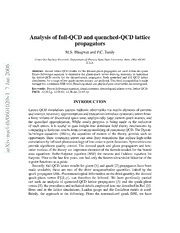
Analysis of full-QCD and quenched-QCD lattice propagators PDF
Preview Analysis of full-QCD and quenched-QCD lattice propagators
Analysis of full-QCD and quenched-QCD lattice propagators M.S. Bhagwat and P.C. Tandy CenterforNuclearResearch,DepartmentofPhysics,KentStateUniversity,Kent,Ohio44242 U.S.A. 6 0 0 Abstract. Recent lattice-QCD results for the dressed-gluonpropagatorare used within the quark 2 Dyson-Schwinger equation to determine the gluon-quark vertex dressing necessary to reproduce the lattice-QCD results for the dressed-quark propagator. Both quenched and full QCD lattice n simulations,forarangeoflowquarkcurrentmasses,areanalyzed.Thechiralextrapolationismade a J throughthiscontinuumDSEform.Resultingchiralandphysicalpionobservablesareinvestigated. 7 Keywords: Dyson-Schwingerequation,chiralsymmetry,dressedquark-gluonvertex,lattice-QCD. PACS: 12.38.Lg,12.38.Gc,12.38.Aw,24.85.+p 1 v 0 INTRODUCTION 2 0 1 Lattice-QCD simulations address hadronic observables via matrix elements of currents 0 6 andsources;necessaryapproximationsandtruncationsintroducesystematicerrorsfrom: 0 a finite volume of discretized space-time, unphysically large current quark masses, and / h the quenched approximation. While steady progress is being made in the reduction t of such errors, it is useful to gain insight into dominant field theory mechanisms by - l c comparingtohadronicresultsfromcovariantmodelingofcontinuumQCD.TheDyson- u Schwinger equations (DSEs), the equations of motion of the theory, provide such an n opportunity. Here systematic errors can arise from truncations that replace high-order : v correlationsbyinfraredphenomenologyoflow-ordern-pointfunctions.Symmetriescan i X provide significant quality control. The dressed quark and gluon propagators and low- r order vertices of the theory are important elements of the kernels needed for the bound a state equations: Bethe-Salpeter equation (BSE) for mesons and Faddeev equation for baryons.Prior tothelast few years, onehad only theknownultra-violetbehaviorofthe n-pointfunctionsas aguide. Recently, full-QCD lattice results for gluon [1] and quark [2] propagators have been made available; these are two of the three nonperturbative quantities linked by the quarkpropagatorDSE.Phenomenologicalinformationonthethirdquantity,thedressed quark-gluon vertex G a(k,p), can therefore be inferred. We have previously carried n out such an analysis of quenched-QCD lattice propagators [3] and the quark-gluon vertex[4]; theprocedures andtechnical detailsemployedherearedescribed inRef. [3]. Here, and in the lattice simulations, Landau gauge and the Euclidean metric is used. Briefly, the approach is the following. From the renormalized quark DSE, we have 0.4 Chiral limit DSE 100 16 MeV, m a = 0.01 0.3 32 MeV, m a = 0.02 0.2 47 MeV, m a = 0.03 -2 V) 63 MeV, m a = 0.04 10 e G p) (0.1 (T)|S10-4 M( D| DSE/Full QCD 10-6 DSE/Qu-QCD 1 c. conjg. pole DSE/Maris-Tandy 0.02 -8 0 1 2 3 4 10 0 10 20 30 p (GeV) T (GeV-1) FIGURE1. LeftPanel:Full-QCDlatticeresults[2]reproducedfromthefull-QCDlatticegluonprop- agator[1] viathecontinuumDSE. Noteverticallogscale.Valuesoflatticem andmaareshown;Right Panel:FouriertransformoftheDiracscalarpartofthechiralS(p).Cuspsindicateconfinement. S−1(p)=Z ig ·p+Z m(m )+S ′(p,L )and theregulatedself-energy is 2 4 L l a S ′(p,L )=Z1 g2Dmn (p−q) g m S(q)G an (p−q,p) . (1) Z 2 q Here L is the regularization mass scale, the Z(m 2,L 2) are the usual constants i from renormalization at scale m . Two are required so that as p2 →m 2, we have S−1(p)→ig ·p+m(m ). The lattice results for S(p) are given in terms of S(p)=Z(p2,m 2)/ (ig ·p+M(p2)). We compare by solving (1) with the kernel factors Z1g2Dmn (k)G an (k,p)replaced byDlmnat (k)l2a gn G 1(k2).HereDlmnat (k)isafit tothelattice gluon propagator and the quantity G (k2) is a phenomenological vertex amplitude de- 1 terminedso that theDSE solutionfor S(p) fits the latticedata. In general thetransverse vertex has eight amplitudes and a dependence upon two momenta; however the data being fitted here do not warrant more. We note that one may identify the kernel as 4pa eff(k2)D0mn (k) where D0mn is the 0th order gluon propagator. We ensure that the leading log behavior of all quantities conform to the 1-loop renormalization group behaviorofQCD. RESULTS TABLE 1. Chiral condensate and pion decay constant (chiral fp0,physical fp )fromthelattice-guidedDSEkernel. Expt Full-QCD Qu-QCD hq¯qi m =1GeV -(0.24GeV)3 -(0.23GeV)3 -(0.19GeV)3 fp0 0.090GeV 0.072GeV 0.063GeV fp 0.092GeV 0.075GeV 0.066GeV Our fit to the full-QCD Dlat (k) uses the “model A” form previously employed for mn quenched data [5] but now with N =3 and the new parameter values: A = 3.25, f L =0.54, a =1.15 and Z =1.22. Our fit gavepriority to M(p) for thefour available g g values of lattice ma shown, along with the results, in the left panel of Fig. 1. The parameterized form used for G (k2) is the same as we have previously used [3] for 1 the quenched lattice case. The (dimensionless) parameters of G (k2) found here for 1 the full-QCD case are: a =4.5,a =2.1,a = 18.1,b= 0.31. The result of the chiral 1 2 3 extrapolation provided by the DSE kernel is also shown. The lattice current masses are equally spaced and, in the region p &3GeV, the lattice results are only approximately so;thema=0.01casedeviatesmostfromthepattern.TheDSE fithas been madewith theconstraintthattheM(p,m)approach thecorrect ratio. IfapropagatorofafieldtheoryinEuclideanmetricviolatestheOsterwalder-Schrader axiomofrelectionpositivity[6],thenthisisasufficientconditionforconfinementofthe corresponding excitation [7]. In the right panel of Fig. 1 we display the magnitude of the Fourier transform of s (p ,~p = 0), the Dirac scalar amplitude of the chiral limit s 4 quark propagator. For a free particle with mass m, D (T)(cid:181) exp(−mT). The cusps S indicate changes of sign and thus confinement in both quenched and full-QCD. The dottedlinecorrespondstoapropagatorthathasasinglepairofcomplexconjugatepoles at p2 =−0.3092±i0.1922 GeV2. The dashed curve corresponds to the ladder-rainbow modelthatdescribesa largevarietyoflightquark observables[8]. The form of the deduced DSE kernel allows a chiral symmetry-preserving Bethe- Salpeter kernel to be obtained as in the ladder-rainbow case [9]. This produces the chiralphysicsobservablesshowninTable1.Full-QCDevidentlyproducesanacceptable condensate, while the quenched approximation underestimates by a factor of two [3]. The values of fp , both chiral and physical, are marginally improved by full-QCD but theyremainabout15% toolow. ACKNOWLEDGMENTS Conversations with Craig Roberts and Pieter Maris have been valuable. This work has been partiallysupportedby NSFgrant no. PHY-0301190. REFERENCES 1. P.O.Bowman,U.M.Heller,D.B.Leinweber,M.B.Parappilly,andA.G.Williams,Phys.Rev.D70, 034509(2004),hep-lat/0402032. 2. P.O.Bowman,etal.,Phys.Rev.D71,054507(2005),hep-lat/0501019. 3. M. S. Bhagwat, M. A. Pichowsky,C. D. Roberts, and P. C. Tandy, Phys. Rev. C68, 015203(2003), nucl-th/0304003. 4. M.S.Bhagwat,andP.C.Tandy,Phys.Rev.D70,094039(2004),hep-ph/0407163. 5. D.B. Leinweber,J. I.Skullerud,A. G.Williams, andC. Parrinello,Phys.Rev.D60,094507(1999), hep-lat/9811027. 6. K.Osterwalder,andR.Schrader,Commun.Math.Phys.42,281(1975). 7. G.Krein,C.D.Roberts,andA.G.Williams,Int.J.Mod.Phys.A7,5607–5624(1992). 8. P.Maris,andP.C.Tandy,Phys.Rev.C60,055214(1999),nucl-th/9905056. 9. A.Bender,C.D.Roberts,andL.VonSmekal,Phys.Lett.B380,7–12(1996),nucl-th/9602012.
